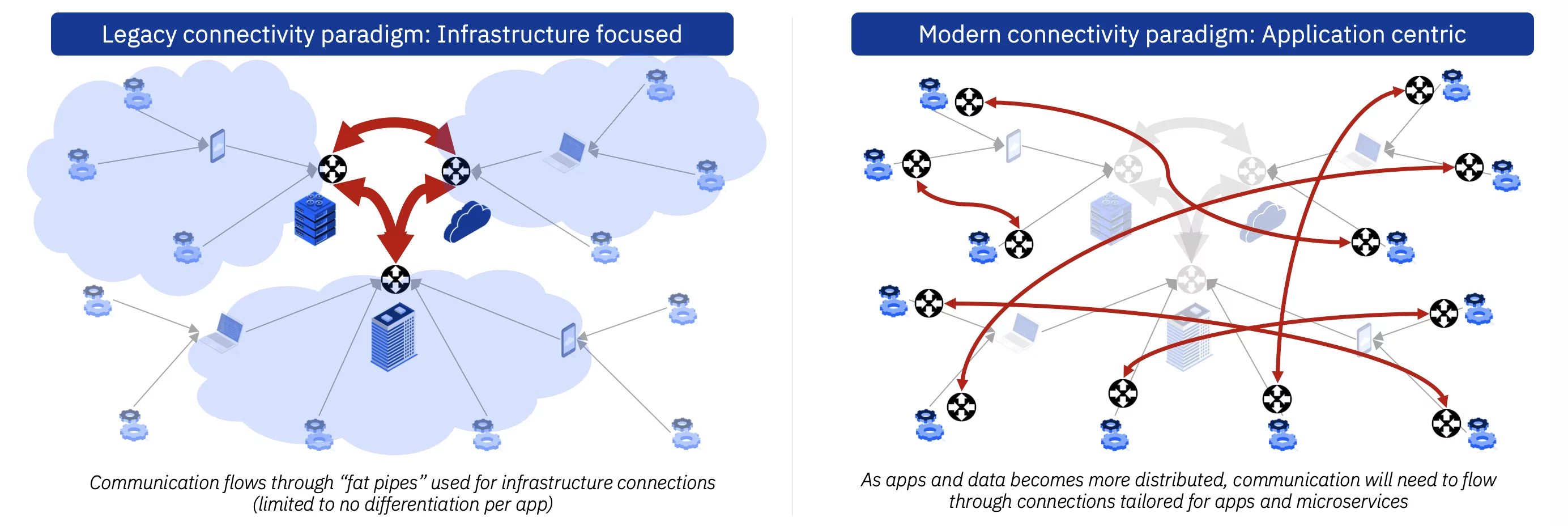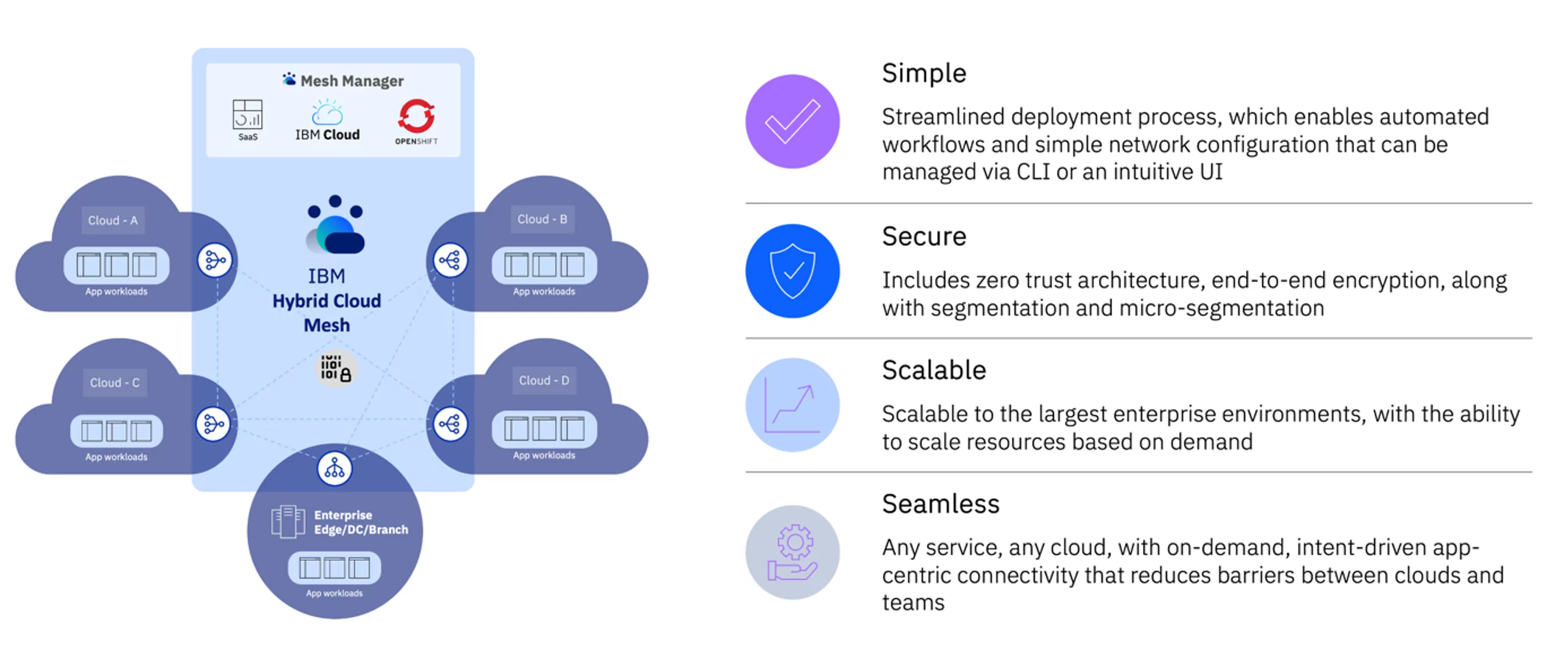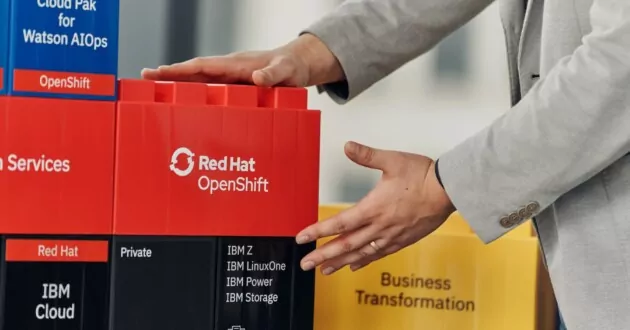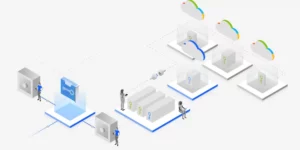
Hybrid Cloud Mesh, which is generally available now, is revolutionizing application connectivity across hybrid multicloud environments. Let’s draw a comparison between Hybrid Cloud Mesh and a typical service mesh to better understand the nuances of these essential components in the realm of modern enterprise connectivity. This comparison deserves merit because both the solutions are focused on application-centric connectivity albeit in a different manner.
Before we delve into the comparison, let’s briefly revisit the concept of Hybrid Cloud Mesh and a typical service mesh.

Hybrid Cloud Mesh
Hybrid Cloud Mesh is a modern application-centric connectivity solution that is simple, secure, scalable and seamless. It creates a secure network overlay for applications distributed across cloud, edge and on-prem and holistically tackles the challenges posed by distribution of services across hybrid multicloud.

Service mesh
A service mesh is a configurable infrastructure layer that manages all connectivity requirements between microservices. It manages service-to-service communication, providing essential functionalities such as service discovery, load balancing, encryption and authentication.
Language libraries for connectivity have partial and inconsistent implementation of traffic management features and are difficult to maintain and upgrade. A service mesh eliminates such libraries and allows services to focus on their business logic and communicate with other services without adding any connectivity logic in situ.
Hybrid Cloud Mesh versus service mesh: a comparative analysis
1. Scope of connectivity
- Hybrid Cloud Mesh: Goes beyond microservices within a containerized application, extending connectivity to applications regardless whether they’re form-factor deployed across on-premises, public cloud and private cloud infrastructure. Its scope encompasses a broader range of deployment scenarios.
- Service mesh: Primarily focuses on managing communication between microservices within a containerized environment. Although many service meshes have started looking outward, enabling multi-cluster any-to-any connectivity.
2. Multicloud connectivity
- Hybrid Cloud Mesh: Seamlessly connects applications across hybrid multicloud environments, offering a unified solution for organizations with diverse cloud infrastructures.
- Service mesh: Typically designed for applications deployed within a specific cloud or on-premises environment. Many service meshes have expanded scope to multicloud connectivity, but they are not fully optimized for it.
3. Traffic engineering capabilities
- Hybrid Cloud Mesh: Utilizes waypoints to support path optimization for cost, latency, bandwidth and others,. enhancing application performance and security.
- Service mesh: No traffic engineering capabilities. Primarily focuses on internal traffic management within the microservices architecture.
4. Connectivity intent expression
- Hybrid Cloud Mesh: Allows users to express connectivity intent through the UI or CLI, providing an intuitive, user-friendly experience with minimal learning curve.
- Service mesh: Requires users to implement complex communication patterns in the sidecar proxy using configuration files. Service mesh operations entail complexity and demand a substantial learning curve. The expert team responsible for managing the service mesh must consistently invest time and effort to effectively utilize and maintain the service mesh. Due to steep learning curve and tooling required (such as integration with CI/CD pipeline or day 0 to day 2 automation), service meshes can be adopted only after customers gain a certain scale to make the investment worthwhile.
5. Management and control plane
- Hybrid Cloud Mesh: Employs a centralized SaaS-based management and control plane, enhancing ease of use and providing observability. Users interact with the mesh manager through a user-friendly UI or CLI.
- Service mesh: Often utilizes decentralized management, with control planes distributed across the microservices, requiring coordination for effective administration.
6. Integration with gateways
- Hybrid Cloud Mesh: Integrates with various gateways, promoting adaptability to diverse use cases and future-ready for upcoming gateway technologies.
- Service mesh: Primarily relies on sidecar proxies for communication between microservices within the same cluster. Typically features on the proxy are extended to meet requirements.
7. Application discovery
- Hybrid Cloud Mesh: Mesh manager continuously discovers and updates multicloud deployment infrastructure, automating the discovery of deployed applications and services.
- Service mesh: Typically relies on service registration and discovery mechanisms within the containerized environment.
8. Dynamic network maintenance
- Hybrid Cloud Mesh: Automatically adapts to dynamic changes in workload placement or environment, enabling resilient and reliable connectivity at scale without manual intervention.
- Service mesh: Usually, the day 2 burden to manage a service mesh connecting applications across multicloud is huge due to complexity of operations required to manage dynamic infrastructure changes. It requires manual adjustments to accommodate changes in microservices deployed in a multicloud environment. There’s significant effort in keeping it running such as—upgrades, security fixes and others apart from infrastructure changes. This takes away a lot of time and very little time is left for implementing new features.
9. Infrastructure overhead
- Hybrid Cloud Mesh: Data plane is composed of a limited number of edge-gateways and waypoints.
- Service mesh: Significant overhead due to sidecar proxy architecture which requires 1 sidecar-proxy for every workload.
10. Multitenancy
- Hybrid Cloud Mesh: Offers robust multitenancy; moreover, subtenants can be created to maintain separation between different departments or verticals within an organization.
- Service mesh: May lack the capability to accommodate multitenancy or a subtenant architecture. Few customers may create a separate service mesh per cluster to keep the tenants separate. Hence, they must deploy and manage their own gateways to connect various service meshes.
Take the next step with Hybrid Cloud Mesh
We are excited to showcase a tech preview of Hybrid Cloud Mesh supporting the use of Red Hat® Service Interconnect gateways simplifying application connectivity and security across platforms, clusters and clouds. Red Hat Service Interconnect, announced 23 May 2023 at Red Hat Summit, creates connections between services, applications and workloads across hybrid necessary environments.
We’re just getting started on our journey building comprehensive hybrid multicloud automation solutions for the enterprise. Hybrid Cloud Mesh is not just a network solution; it’s engineered to be a transformative force that empowers businesses to derive maximum value from modern application architecture, enabling hybrid cloud adoption and revolutionizing how multicloud environments are utilized. We hope you join us on the journey.
Learn more about Hybrid Cloud MeshWas this article helpful?
YesNo
IBM Newsletters
Get our newsletters and topic updates that deliver the latest thought leadership and insights on emerging trends.Subscribe now More newsletters
- SEO Powered Content & PR Distribution. Get Amplified Today.
- PlatoData.Network Vertical Generative Ai. Empower Yourself. Access Here.
- PlatoAiStream. Web3 Intelligence. Knowledge Amplified. Access Here.
- PlatoESG. Carbon, CleanTech, Energy, Environment, Solar, Waste Management. Access Here.
- PlatoHealth. Biotech and Clinical Trials Intelligence. Access Here.
- Source: https://www.ibm.com/blog/hybrid-cloud-mesh-versus-service-mesh/
- :has
- :is
- :not
- 08
- 1
- 10
- 15%
- 2019
- 2023
- 2024
- 22
- 23
- 29
- 30
- 300
- 31
- 39
- 40
- 400
- 46
- 7
- 9
- a
- About
- ABSTRACT
- abundance
- accommodate
- across
- adapts
- adding
- address
- adjustments
- administration
- adopted
- Adoption
- Advertising
- After
- aggregate
- align
- All
- allows
- Although
- among
- amp
- an
- analytics
- and
- announced
- any
- apart
- APIs
- app
- Application
- Application Development
- applications
- approach
- architecture
- ARE
- AREA
- article
- AS
- assessment
- At
- Authentication
- author
- automatically
- automating
- Automation
- available
- away
- back
- balancing
- Bandwidth
- Battle
- BE
- because
- become
- Better
- between
- Beyond
- Blog
- Blue
- both
- briefly
- broader
- Building
- burden
- business
- businesses
- but
- button
- by
- CAN
- capabilities
- capability
- carbon
- card
- Cards
- cases
- CAT
- Category
- centralized
- certain
- challenge
- challenges
- Changes
- check
- circles
- class
- client
- Close
- Cloud
- cloud adoption
- cloud infrastructure
- Cluster
- collaboration
- colleagues
- color
- comes
- Common
- communicate
- Communication
- comparison
- complex
- complexity
- components
- composed
- comprehensive
- computer
- concept
- Concerns
- Configuration
- Connect
- Connecting
- Connections
- Connectivity
- connects
- consistently
- Container
- Containers
- context
- continue
- continuous
- continuously
- control
- coordination
- Cost
- Costs
- covered
- create
- created
- creates
- Creating
- CSS
- Current
- curve
- custom
- Customers
- cycle
- data
- Date
- day
- December
- decentralized
- Decoding
- Default
- definitions
- deliver
- delve
- Demand
- departments
- Dependency
- deploy
- deployed
- deployment
- derive
- description
- deserves
- designed
- Developer
- Development
- Devices
- DevOps
- diagnosing
- different
- difficult
- disappointment
- Discovers
- discovery
- distributed
- distribution
- diverse
- dns
- dominant
- draw
- due
- dynamic
- ease
- ease of use
- easy
- ecosystem
- Edge
- Effective
- effectively
- effort
- eliminates
- embracing
- emerged
- emergence
- emerging
- employs
- empowers
- enabling
- encompasses
- encryption
- engineered
- Engineering
- enhancing
- Enter
- Enterprise
- Environment
- environments
- essential
- Ether (ETH)
- Every
- excited
- execution
- Exit
- expanded
- expectations
- experience
- expert
- express
- extended
- extending
- extends
- false
- Features
- few
- Files
- fixes
- Focus
- focused
- focuses
- focusing
- follow
- fonts
- For
- Force
- from
- fully
- functionalities
- future
- Gain
- Gartner
- gateway
- generally
- generator
- get
- getting
- Goes
- Grid
- hat
- Have
- Heading
- height
- helpful
- helps
- hence
- highly
- hope
- hosting
- How
- However
- HTTPS
- huge
- Hybrid
- hybrid cloud
- Hype
- IBM
- ICO
- ICON
- image
- images
- implement
- implementation
- implementing
- in
- index
- industry
- Infrastructure
- infrastructures
- Initiates
- insights
- Integrates
- integration
- intent
- interact
- internal
- intervention
- into
- intricacies
- intricate
- intrinsic
- introduced
- intuitive
- Invest
- investment
- issues
- IT
- ITS
- January
- Java
- join
- Join us
- journey
- jpg
- just
- Keep
- keeping
- Lack
- large
- Latency
- latest
- layer
- Leadership
- leading
- learning
- Led
- left
- Level
- Liberty
- libraries
- lifecycle
- Limited
- linux
- little
- load
- local
- locale
- logic
- looking
- Lot
- maintain
- make
- manage
- management
- Management and control
- manager
- manages
- managing
- manner
- manual
- many
- March
- max-width
- maximum
- May..
- mechanisms
- Meet
- meeting
- Merit
- mesh
- microservices
- migrate
- migrating
- min
- minimal
- minutes
- Mobile
- Modern
- monitoring
- more
- Moreover
- most
- must
- Navigation
- necessary
- network
- networking
- New
- New Features
- Newsletters
- next
- no
- nothing
- now
- Nuance
- nuances
- number
- of
- off
- offering
- Offers
- often
- on
- only
- open
- Operations
- optimization
- optimized
- or
- organization
- organizations
- Other
- Others
- our
- over
- own
- page
- path
- patterns
- Peak
- per
- performance
- PHP
- pipeline
- placed
- placement
- plane
- Planes
- platform
- Platforms
- plato
- Plato Data Intelligence
- PlatoData
- plugin
- policy
- posed
- position
- Post
- present
- Preview
- primarily
- primary
- private
- Problem
- Product
- product manager
- promoting
- provides
- providing
- proxies
- proxy
- public
- Public cloud
- range
- Reading
- realm
- recent
- recovery
- Red
- Red Hat
- reflect
- Regardless
- Registration
- reliable
- requests
- required
- Requirements
- requires
- resilient
- responsible
- responsive
- REST
- Revolutionizing
- rising
- robots
- robust
- running
- same
- scalable
- Scale
- scenarios
- scope
- Screen
- scripts
- seamless
- seamlessly
- secure
- security
- seems
- seo
- separate
- server
- service
- Services
- Short
- showcase
- significant
- Simple
- simplifying
- site
- skills
- small
- Software
- solution
- Solutions
- specific
- Sponsored
- spring
- spring boot
- squares
- start
- started
- State
- steering
- Step
- Steps
- strategies
- subscribe
- substantial
- such
- Summit
- support
- Supporting
- SVG
- Tackles
- takes
- team
- tech
- Technologies
- tertiary
- thanks
- that
- The
- The Future
- The State
- the world
- their
- Them
- theme
- There.
- These
- they
- this
- thought
- thought leadership
- Through
- time
- Title
- to
- tolerance
- top
- topic
- touches
- traditionally
- traffic
- transformative
- Trends
- type
- typical
- typically
- ui
- underlying
- underneath
- understand
- understanding
- unified
- upcoming
- Updates
- upgrade
- URL
- us
- use
- user-friendly
- users
- using
- usually
- utilize
- utilized
- utilizes
- value
- various
- Vehicles
- version
- Versus
- verticals
- very
- View
- W
- we
- whether
- which
- while
- with
- within
- without
- WordPress
- workflows
- working
- world
- worthwhile
- written
- you
- Your
- zephyrnet
















